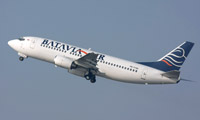News Backgrounder
Boom or bust in Indonesia
Indonesia is experiencing double-digit passenger growth, but it didn’t stop local carrier, Batavia Air, from going bankrupt. While major carriers flourish, others are likely to end up on the scrap heap.
March 1st 2013
When AirAsia group chief executive, Tony Fernandes, announced plans to buy into Indonesian budget operator, Batavia Air, in mid-2012, industry observers saw it as a move to expand his southeast Asian empire following the Malaysian low-cost leader’s move to Jakarta. By October, the US$80 million deal was off. Read More »
 |
| Batavia Air: will not be the last Indonesian airline to go bankrupt |
Now we know why. Due diligence disclosed Batavia was struggling, both financially and operationally, despite flying in one of the region’s fastest growing markets.
Indonesian transport ministry data shows there are 22 active local commercial airlines, not including cargo and charter carriers operating in the country. Analysts said it is becoming increasingly difficult for smaller airlines, without sufficient financial backing, to survive.
Batavia is a case in point. On January 31, it ceased operations after being declared bankrupt by the Central Jakarta Commercial Court following the review of a petition by International Lease Finance Corporation (ILFC). Batavia had failed to pay ILFC $4.68 million for two leased A330s.
Last month, trustees appointed to deal with the company disclosed it had debt of more than $123.58 million. It couldn’t pay employees or business partners.
Batavia also owes money to state-owned airport operator Angkasa Pura, oil and gas company Pertamina and maintenance, repair, and overhaul (MRO) firm, GMFAeroAsia, the maintenance arm of Garuda Indonesia.
The airline, it has emerged, was the victim of market pressures in a country where domestic air traffic has been growing at up to 15% annually in recent years.
The Indonesia National Air Carriers Association (INACA) said around 70 million scheduled passengers travelled domestically last year. It is projected this figure will reach 100 million passengers in 2015 and 180 million by 2021.
Today, Lion Air has just under half of Indonesia’s market share, Garuda about 25%, Sriwijaya Air around 12% and Merpati Nusantara 3%. Batavia, with a fleet of 34 aircraft, had 11%.
Shukor Yusof, Singapore-based aviation analyst at Standard & Poor’s said: “Competition has intensified and the weak will be weeded out. Smaller players will find it increasingly difficult to stay solvent.”
Batavia found out the hard way. A number of factors combined to bring about its downfall. Firstly, it had leased aircraft to fly Indonesian pilgrims during the lucrative Haj season, but it failed to win a contract to do so from Indonesia’s religious affairs ministry.
In the meantime, it was being forced to sell tickets on domestic flights at a loss. As a former commercial director at the airline, Sukirno Sukarna, told local media: “The main problem was that competition was too tough.
“Batavia’s fleet is old, it could not sell tickets at the top-end price limit set by the government. Other airlines have newer planes and can set their prices higher.”
Although Batavia had load factors as high as 80%, it was unable to cover costs. It sold tickets at prices far below break-even, added Sukarna. Last year, with revenue of $434 million, it lost $32 million.
Garuda and its domestic budget arm CitiLink, Lion, Mandala (part-owned by Tiger Airways), Sriwijiya and AirAsia Indonesia are all in the process of rapidly expanding their capacity in Indonesia, intensifying the battle to fill seats. The prospects for Batavia to turn its situation around were bleak.
Last month, the number of domestic seats in the market was 18%, or more than one million seats higher than in the same month last year. In just five years, the Indonesian domestic seat market has almost doubled, growing from 3.5 million seats in February 2008 to 6.8 million last month.
The growth is dominated by budget operators. John Grant, executive vice-president of OAG, said low-cost carriers had become an increasingly important contributor to domestic capacity growth.
The country’s major operators have committed to the delivery of around 200 aircraft in the next three years.
Batavia is unlikely to be the last casualty. Said Toto Nursatyo, chief commercial officer at Sriwijaya Air: “This current environment basically allows bigger airlines to get bigger, while smaller airlines will go bust.”